Wild-Grown Romanian Eupatorium cannabinum: Advancing Phyto-Nanocarriers via Maltodextrin Micro-Spray Encapsulation—Metabolite Profiling, Antioxidant, Antimicrobial, and Cytotoxicity Insights
Abstract
1. Introduction
2. Materials and Methods
2.1. Chemicals and Reagents
2.2. Cell Lines
2.3. Bacterial Strains
2.4. Plant Material
2.5. Preparation of AuNPs
2.6. Plant Sample Preparation for Chemical Screening
2.7. GC–MS Analysis
2.8. MS Analysis
2.9. Spray Drying Process
2.10. Phytocarrier System Preparation (EC-AuNPs System)
2.11. Preparation of Maltodextrin–E. cannabinum Carrier (MEC Carrier)
2.12. Preparation of Maltodextrin–EC-AuNPs System (MEC-AuNPs System)
2.13. Characterization of Carriers
2.13.1. FTIR Spectroscopy
2.13.2. XRD Analysis
2.13.3. SEM Analysis
2.13.4. DLS Particle Size Distribution Analysis
2.14. Encapsulation Efficiency, Loading Capacity and Encapsulation Yield
2.15. Estimation of Total Phenolic Content and Antioxidant Activity
2.15.1. Sample Preparation Procedure
2.15.2. TPC Assay
2.15.3. FRAP Assay
2.15.4. DPPH Radical Scavenging Assay
2.16. Antimicrobial Activity
2.17. Cell Culture Procedure
2.17.1. Cell Culture and Treatment
2.17.2. MTT Assay
2.18. Statistical Analysis
3. Results
3.1. GC–MS Analysis of E. cannabinum
3.2. MS Analysis
3.3. Chemical Screening
3.4. Key Aroma-Active Compounds Forming Different Flavor Characteristics
3.5. Phytocarrier System
3.5.1. FTIR Analysis
3.5.2. XRD Analysis
3.5.3. SEM–EDX Analysis
3.5.4. DLS Analysis
3.5.5. PSD Analysis by Laser Diffraction
3.5.6. Encapsulation Efficiency, Loading Capacity and Encapsulation Yield
3.6. Thermal Behavior Study
3.7. TPC and Evaluation of Antioxidant Potential
3.8. Antimicrobial Screening
3.9. Cell Viability Assay
4. Discussion
4.1. Chemical Screening
4.2. Innovative Phytocarrier Systems with Antioxidant, Antimicrobial, and Cytotoxic Potential
5. Conclusions
Supplementary Materials
Author Contributions
Funding
Institutional Review Board Statement
Informed Consent Statement
Data Availability Statement
Acknowledgments
Conflicts of Interest
References
- Săvulescu, T.; Nyarady, E.I. (Eds.) Flora R.P.R., 1st ed.; Romanian Academy Publishing House: Bucharest, Romania, 1964; Volume IX, pp. 168–171. (In Romanian) [Google Scholar]
- Ciocârlan, V. Flora ilustrată a României. Pteridophyta et Spermatophyta, 3rd ed.; Ceres Publishing House: Bucharest, Romania, 2009; pp. 761–770. (In Romanian) [Google Scholar]
- Sârbu, I.; Ştefan, N.; Oprea, A. Plante Vasculare din România. Determinator Ilustrat de Teren, 1st ed.; Victor B Victor Publishing House: Bucharest, Romania, 2013; pp. 756–758. (In Romanian) [Google Scholar]
- Tutin, T.G.; Heywood, V.H.; Burges, N.A.; Moore, D.M.; Valentine, D.H.; Walters, S.M.; Webb, D.A. (Eds.) Flora Europaea. Vol. 4: Plantaginaceae to Compositae (and Rubiaceae), 1st ed.; Cambridge University Press: Cambridge, UK, 1976; pp. 103–109. [Google Scholar]
- Ionita, L.; Grigore, A.; Pirvu, L.; Draghici, E.; Bubueanu, C.; Ionita, C.; Panteli, M.; Dobre, N. Pharmacological activity of an Eupatorium cannabinum L. extract. Rom. Biotechnol. Lett. 2013, 18, 8779–8786. Available online: https://rombio.unibuc.ro/wp-content/uploads/2022/05/18-6-6.pdf (accessed on 18 November 2024).
- Liu, P.Y.; Liu, D.; Li, W.H.; Zhao, T.; Sauriol, F.; Gu, Y.C.; Shi, Q.W.; Zhang, M.L. Chemical Constituents of Plants from the Genus Eupatorium (1904–2014). Chem. Biodivers. 2015, 12, 1481–1515. [Google Scholar] [CrossRef] [PubMed]
- Geng, H. Chemical Constituents and Their Bioactivities of Plants from the Genus Eupatorium (2015–Present). Biology 2024, 13, 288. [Google Scholar] [CrossRef]
- Lexa, A.; Fleurentin, J.; Younos, C.; Mortiert, F. Study of antihepatotoxicity of Eupatorium cannabinum L. in mice. An adequate method of screening in vivo antihepatotoxic natural principles. Phytother. Res. 1990, 4, 148–151. [Google Scholar] [CrossRef]
- Flamini, G.; Cioni, P.L.; Morelli, I. Analysis of the Essential Oil of the Leaves and Flowers/Fruits of Eupatorium cannabinum L. from South Tuscany (Central Italy). J. Essent. Oil Res. 2003, 15, 127–129. [Google Scholar] [CrossRef]
- Al-Snafi, A.E. Chemical constituents, pharmacological and therapeutic effects of Eupatorium cannabinum—A review. Indo Am. J. Pharm. Sci. 2017, 4, 160–168. [Google Scholar] [CrossRef]
- Stevens, J.F.; Elema, E.T.; Wollenweber, E. Exudate flavonoids of Eupatorium cannabinum. Biochem. Syst. Ecol. 1995, 23, 451–452. [Google Scholar] [CrossRef]
- Vollmar, A.; Schäfer, W.; Wagner, H. Immunologically active polysaccharides of Eupatorium cannabinum and Eupatorium perfoliatum. Phytochemistry 1986, 25, 377–381. [Google Scholar] [CrossRef]
- Woerdenbag, H.J. Eupatorium cannabinum L. A review emphasizing the sesquiterpene lactones and their biological activity. Pharm. Weekbl. Sci. 1986, 8, 245–251. [Google Scholar] [CrossRef]
- Chen, J.J.; Tsai, Y.C.; Hwang, T.L.; Wang, T.C. Thymol, benzofuranoid, and phenylpropanoid derivatives: Anti-inflammatory constituents from Eupatorium cannabinum. J. Nat. Prod. 2011, 74, 1021–1027. [Google Scholar] [CrossRef]
- Rücker, G.; Schenkel, E.P.; Manns, D.; Mayer, R.; Hausen, B.M.; Heiden, K. Allergenic sesquiterpene lactones from Eupatorium cannabinum L. and Kaunia rufescens (Lund ex de Candolle). Nat. Toxins 1997, 5, 223–227. [Google Scholar] [CrossRef]
- Judzentiene, A.; Garjonyte, R.; Budiene, J. Variability, toxicity, and antioxidant activity of Eupatorium cannabinum (hemp agrimony) essential oils. Pharm. Biol. 2016, 54, 945–953. [Google Scholar] [CrossRef] [PubMed]
- Piwowarski, J.P.; Waltenberger, B.; Stuppner, H.; Kiss, A.K.; Granica, S. The analysis of phenolic compounds from the aerial parts of Eupatorium cannabinum L. subsp. cannabinum. Biochem. Syst. Ecol. 2018, 79, 37–43. [Google Scholar] [CrossRef]
- Grigore, A.; Neagu, G.; Dobre, N.; Albulescu, A.; Ionita, L.; Ionita, C.; Albulescu, R. Evaluation of antiproliferative and protective effects of Eupatorium cannabinum L. extracts. Turk. J. Biol. 2018, 42, 334–344. [Google Scholar] [CrossRef] [PubMed]
- Abuali, M.; Shams Ardekani, M.R.; Rezadoost, H.; Vazirian, M.; Balaei-Kahnamoei, M.; Hamzeloo-Moghadam, M. Cytotoxic Effects of Eupatorium cannabinum on MCF-7 Human Breast Cancer Cell Line. Res. J. Pharmacogn. 2021, 8, 69–75. [Google Scholar] [CrossRef]
- Woerdenbag, H.J.; Hendriks, H.; Malingré, T.h.M.; van Stralen, R.; van den Berg, K.J.; Konings, A.W.T. In vitro cytotoxicity of sesquiterpene lactones from Eupatorium cannabinum L. and semi-synthetic derivatives from eupatoriopicrin. Phytother. Res. 1988, 2, 109–114. [Google Scholar] [CrossRef]
- Shahtaghi, Y.; Hamzeloo-Moghadam, M.; Mohammadi Motamed, S.; Esmaeili, S. The Cytotoxicity of Eupatorium cannabinum Methanolic Extract in a Human Breast Adenocarcinoma Cell Line (MCF-7). Int. Pharm. Acta 2018, 1, 144–145. [Google Scholar] [CrossRef]
- Chen, L.C.; Lee, T.H.; Sung, P.J.; Shu, C.W.; Lim, Y.P.; Cheng, M.J.; Kuo, W.L.; Chen, J.J. New Thymol Derivatives and Cytotoxic Constituents from the Root of Eupatorium cannabinum ssp. asiaticum. Chem. Biodivers. 2014, 11, 1374–1380. [Google Scholar] [CrossRef]
- Ribeiro-Varandas, E.; Ressurreição, F.; Viegas, W.; Delgado, M. Cytotoxicity of Eupatorium cannabinum L. ethanolic extract against colon cancer cells and interactions with Bisphenol A and Doxorubicin. BMC Complement. Altern. Med. 2014, 14, 264. [Google Scholar] [CrossRef]
- Ahmed, S.K.; Hussein, S.; Qurbani, K.; Ibrahim, R.H.; Fareeq, A.; Mahmood, K.A.; Mohamed, M.G. Antimicrobial resistance: Impacts, challenges, and future prospects. J. Med. Surg. Publ. Health 2024, 2, 100081. [Google Scholar] [CrossRef]
- Ferlay, J.; Colombet, M.; Soerjomataram, I.; Parkin, D.M.; Piñeros, M.; Znaor, A.; Bray, F. Cancer statistics for the year 2020: An overview. Int. J. Cancer 2021, 149, 778–789. [Google Scholar] [CrossRef]
- Balfourier, A.; Kolosnjaj-Tabi, J.; Luciani, N.; Carn, F.; Gazeau, F. Gold-based therapy: From past to present. Proc. Natl. Acad. Sci. USA 2020, 117, 22639–22648. [Google Scholar] [CrossRef]
- Medici, S.; Peana, M.F.; Zoroddu, M.A. Noble Metals in Pharmaceuticals: Applications and Limitations. In Biomedical Applications of Metals, 1st ed.; Rai, M., Ingle, A.P., Medici, S., Eds.; Springer: Cham, Switzerland, 2018; pp. 3–48. [Google Scholar] [CrossRef]
- Ott, I. On the medicinal chemistry of gold complexes as anticancer drugs. Coord. Chem. Rev. 2009, 253, 1670–1681. [Google Scholar] [CrossRef]
- Goddard, Z.R.; Marín, M.J.; Russell, D.A.; Searcey, M. Active targeting of gold nanoparticles as cancer therapeutics. Chem. Soc. Rev. 2020, 49, 8774–8789. [Google Scholar] [CrossRef] [PubMed]
- Yafout, M.; Ousaid, A.; Khayati, Y.; El Otmani, I.S. Gold nanoparticles as a drug delivery system for standard chemotherapeutics: A new lead for targeted pharmacological cancer treatments. Sci. Afr. 2021, 11, e00685. [Google Scholar] [CrossRef]
- Al-Johani, H.; Abou-Hamad, E.; Jedidi, A.; Widdifield, C.M.; Viger-Gravel, J.; Sangaru, S.S.; Gajan, D.; Anjum, D.H.; Ould-Chikh, S.; Hedhili, M.N.; et al. The structure and binding mode of citrate in the stabilization of gold nanoparticles. Nat. Chem. 2017, 9, 890–895. [Google Scholar] [CrossRef]
- Shinohara, S.; Eom, N.; Teh, E.J.; Tamada, K.; Parsons, D.; Craig, V.S.J. The Role of Citric Acid in the Stabilization of Nanoparticles and Colloidal Particles in the Environment: Measurement of Surface Forces Between Hafnium Oxide Surfaces in the Presence of Citric Acid. Langmuir 2018, 34, 2595–2605. [Google Scholar] [CrossRef]
- Yang, L.; Wen, K.-S.; Ruan, X.; Zhao, Y.-X.; Wei, F.; Wang, Q. Response of Plant Secondary Metabolites to Environmental Factors. Molecules 2018, 23, 762. [Google Scholar] [CrossRef]
- Segneanu, A.E.; Grozescu, I.; Sfirloaga, P. The influence of extraction process parameters of some biomaterials precursors from Helianthus annuus. Dig. J. Nanomater. Biostruct. 2013, 8, 1423–1433. Available online: https://chalcogen.ro/1423_Segneanu.pdf (accessed on 18 November 2024).
- Popescu, C.; Fitigau, F.; Segneanu, A.E.; Balcu, I.; Martagiu, R.; Vaszilcsin, C.G. Separation and characterization of anthocyanins by analytical and electrochemical methods. Environ. Eng. Manag. J. 2011, 10, 697–701. [Google Scholar] [CrossRef]
- Vaszilcsin, C.G.; Segneanu, A.E.; Balcu, I.; Pop, R.; Fitigău, F.; Mirica, M.C. Eco-friendly extraction and separation methods of capsaicines. Environ. Eng. Manag. J. 2010, 9, 971–976. [Google Scholar] [CrossRef]
- Segneanu, A.-E.; Damian, D.; Hulka, I.; Grozescu, I.; Salifoglou, A. A simple and rapid method for calixarene-based selective extraction of bioactive molecules from natural products. Amino Acids 2016, 48, 849–858. [Google Scholar] [CrossRef] [PubMed]
- Emran, T.B.; Shahriar, A.; Mahmud, A.R.; Rahman, T.; Abir, M.H.; Siddiquee, M.F.R.; Ahmed, H.; Rahman, N.; Nainu, F.; Wahyudin, E.; et al. Multidrug Resistance in Cancer: Understanding Molecular Mechanisms, Immunoprevention and Therapeutic Approaches. Front. Oncol. 2022, 12, 891652. [Google Scholar] [CrossRef] [PubMed]
- Nath, R.; Roy, R.; Barai, G.; Bairagi, S.; Manna, S.; Chakraborty, R. Modern Developments of Nano Based Drug Delivery System by Combined with Phytochemicals—Presenting New Aspects. Int. J. Sci. Res. Sci. Technol. 2021, 8, 107–129. [Google Scholar] [CrossRef]
- Aparicio-Blanco, J.; Vishwakarma, N.; Lehr, C.M.; Prestidge, C.A.; Thomas, N.; Roberts, R.J.; Thorn, C.R.; Melero, A. Antibiotic resistance and tolerance: What can drug delivery do against this global threat? Drug Deliv. Transl. Res. 2024, 14, 1725–1734. [Google Scholar] [CrossRef]
- Bejenaru, L.E.; Radu, A.; Segneanu, A.-E.; Biţă, A.; Manda, C.-V.; Mogoşanu, G.D.; Bejenaru, C. Innovative Strategies for Upcycling Agricultural Residues and Their Various Pharmaceutical Applications. Plants 2024, 13, 2133. [Google Scholar] [CrossRef]
- Dewi, M.K.; Chaerunisaa, A.Y.; Muhaimin, M.; Joni, I.M. Improved Activity of Herbal Medicines through Nanotechnology. Nanomaterials 2022, 12, 4073. [Google Scholar] [CrossRef]
- Laureanti, E.J.G.; Paiva, T.S.; de Matos Jorge, L.M.; Jorge, R.M.M. Microencapsulation of bioactive compound extracts using maltodextrin and gum arabic by spray and freeze-drying techniques. Int. J. Biol. Macromol. 2023, 253, 126969. [Google Scholar] [CrossRef]
- Xu, Y.; Yan, X.; Zheng, H.; Li, J.; Wu, X.; Xu, J.; Zhen, Z.; Du, C. The application of encapsulation technology in the food Industry: Classifications, recent Advances, and perspectives. Food Chem. X 2024, 21, 101240. [Google Scholar] [CrossRef]
- Bejenaru, C.; Radu, A.; Segneanu, A.-E.; Biţă, A.; Ciocîlteu, M.V.; Mogoşanu, G.D.; Bradu, I.A.; Vlase, T.; Vlase, G.; Bejenaru, L.E. Pharmaceutical Applications of Biomass Polymers: Review of Current Research and Perspectives. Polymers 2024, 16, 1182. [Google Scholar] [CrossRef]
- Segneanu, A.-E.; Marin, C.N.; Herea, D.D.; Stanusoiu, I.; Muntean, C.; Grozescu, I. Romanian Viscum album L.—Untargeted Low-Molecular Metabolomic Approach to Engineered Viscum–AuNPs Carrier Assembly. Plants 2022, 11, 1820. [Google Scholar] [CrossRef] [PubMed]
- Segneanu, A.-E.; Vlase, G.; Vlase, T.; Ciocalteu, M.-V.; Bejenaru, C.; Buema, G.; Bejenaru, L.E.; Boia, E.R.; Dumitru, A.; Boia, S. Romanian Wild-Growing Chelidonium majus—An Emerging Approach to a Potential Antimicrobial Engineering Carrier System Based on AuNPs: In Vitro Investigation and Evaluation. Plants 2024, 13, 734. [Google Scholar] [CrossRef]
- American Standard Test Sieve Series (ASTM). Available online: https://www.endecotts.com/faq/sieves-and-calibration/american-standard-test-sieve-series-astm/ (accessed on 25 November 2024).
- Lucero, M.; Estell, R.; Tellez, M.; Fredrickson, E. A retention index calculator simplifies identification of plant volatile organic compounds. Phytochem. Anal. 2009, 20, 378–384. [Google Scholar] [CrossRef] [PubMed]
- McNaught, A.D.; Wilkinson, A. (Eds.) Compendium of Chemical Terminology: IUPAC Recommendations, 2nd ed.; International Union of Pure and Applied Chemistry (IUPAC) Gold Book; Online Version (2019) Created by S.J. Chalk; Blackwell Scientific Publications: Oxford, UK, 1997. [Google Scholar] [CrossRef]
- NIST Research Library. Available online: https://www.nist.gov/nist-research-library (accessed on 25 November 2024).
- Vargas, V.; Saldarriaga, S.; Sánchez, F.S.; Cuellar, L.N.; Paladines, G.M. Effects of the spray-drying process using maltodextrin on bioactive compounds and antioxidant activity of the pulp of the tropical fruit açai (Euterpe oleracea Mart.). Heliyon 2024, 10, e33544. [Google Scholar] [CrossRef] [PubMed]
- Kyriakoudi, A.; Tsimidou, M.Z. Properties of encapsulated saffron extracts in maltodextrin using the Büchi B-90 nano spray-dryer. Food Chem. 2018, 266, 458–465. [Google Scholar] [CrossRef] [PubMed]
- Segneanu, A.-E.; Vlase, G.; Vlase, T.; Sicoe, C.A.; Ciocalteu, M.V.; Herea, D.D.; Ghirlea, O.-F.; Grozescu, I.; Nanescu, V. Wild-Grown Romanian Helleborus purpurascens Approach to Novel Chitosan Phyto-Nanocarriers—Metabolite Profile and Antioxidant Properties. Plants 2023, 12, 3479. [Google Scholar] [CrossRef]
- Segneanu, A.-E.; Vlase, G.; Vlase, T.; Bejenaru, L.E.; Mogoşanu, G.D.; Buema, G.; Herea, D.-D.; Ciocîlteu, M.V.; Bejenaru, C. Insight into Romanian Wild-Grown Heracleum sphondylium: Development of a New Phytocarrier Based on Silver Nanoparticles with Antioxidant, Antimicrobial and Cytotoxicity Potential. Antibiotics 2024, 13, 911. [Google Scholar] [CrossRef]
- Kavaz, D.; El Faraj, R.E.K. Investigation of composition, antioxidant, antimicrobial and cytotoxic characteristics from Juniperus sabina and Ferula communis extracts. Sci. Rep. 2023, 13, 7193. [Google Scholar] [CrossRef]
- McFarland Standards—Principle, Preparation, Uses, Limitations. Available online: https://microbenotes.com/mcfarland-standards/ (accessed on 25 November 2024).
- Hossain, M.L.; Lim, L.Y.; Hammer, K.; Hettiarachchi, D.; Locher, C. A Review of Commonly Used Methodologies for Assessing the Antibacterial Activity of Honey and Honey Products. Antibiotics 2022, 11, 975. [Google Scholar] [CrossRef]
- Andrews, J.M. Determination of minimum inhibitory concentrations. J. Antimicrob. Chemother. 2001, 48, 5–16. [Google Scholar] [CrossRef]
- Adil, M.; Filimban, F.Z.; Ambrin; Quddoos, A.; Sher, A.A.; Naseer, M. Phytochemical screening, HPLC analysis, antimicrobial and antioxidant effect of Euphorbia parviflora L. (Euphorbiaceae Juss.). Sci. Rep. 2024, 14, 5627. [Google Scholar] [CrossRef]
- Činčala, Ľ.; Illeová, V.; Antošová, M.; Štefuca, V.; Polakovič, M. Investigation of plant sources of hydroperoxide lyase for 2(E)-hexenal production. Acta Chim. Slovaca 2015, 8, 156–165. [Google Scholar] [CrossRef]
- Cao, L.; Guo, X.; Liu, G.; Song, Y.; Ho, C.T.; Hou, R.; Zhang, L.; Wan, X. A comparative analysis for the volatile compounds of various Chinese dark teas using combinatory metabolomics and fungal solid-state fermentation. J. Food Drug Anal. 2018, 26, 112–123. [Google Scholar] [CrossRef] [PubMed]
- Milovanović, I.L.J.; Mišan, A.Č.; Sakač, M.B.; Čabarkapa, I.S.; Šarić, B.M.; Matić, J.J.; Jovanov, P.T. Evaluation of a GC–MS method for the analysis of oregano essential oil composition. Food Feed Res. 2009, 36, 75–79. Available online: http://foodandfeed.fins.uns.ac.rs/uploads/Magazines/magazine_49/evaluation-of-a-gc-ms-method-for-the-analysis-of-oregano-essential-oil-composition.pdf (accessed on 20 November 2024).
- Sedikelo, G.K.; Lenetha, G.G.; Malebo, N.J. Chromatography–mass spectrometry and chemical characteristics of Thymus zygis and Cymbopogon winterianus essential oils: Possible insect repellents. Sci. Afr. 2022, 15, e01095. [Google Scholar] [CrossRef]
- Al Hashmi, L.S.; Hossain, M.A.; Weli, A.M.; Al-Riyami, Q.; Al-Sabahi, J.N. Gas chromatography–mass spectrometry analysis of different organic crude extracts from the local medicinal plant of Thymus vulgaris L. Asian Pac. J. Trop. Biomed. 2013, 3, 69–73. [Google Scholar] [CrossRef]
- Hou, W.; Han, Q.; Gong, H.; Liu, W.; Wang, H.; Zhou, M.; Min, T.; Pan, S. Analysis of volatile compounds in fresh sturgeon with different preservation methods using electronic nose and gas chromatography/mass spectrometry. RSC Adv. 2019, 9, 39090–39099. [Google Scholar] [CrossRef]
- Ghasemi, M.; Babaeian Jelodar, N.; Modarresi, M.; Bagheri, N.; Jamali, A. Increase of Chamazulene and α-Bisabolol Contents of the Essential Oil of German Chamomile (Matricaria chamomilla L.) Using Salicylic Acid Treatments under Normal and Heat Stress Conditions. Foods 2016, 5, 56. [Google Scholar] [CrossRef]
- Gebrehiwot, H.; Dekebo, A.; Shenkute, K.; Ensermu, U.; Endale, M. Chemical composition, antibacterial and antioxidant activities of essential oils from Cyphostemma adenocaule and Ziziphus spinachristi. Bull. Chem. Soc. Ethiop. 2024, 38, 167–186. [Google Scholar] [CrossRef]
- Syamsudin, T.S.; Hafsah, H.; Iriawati, I. Data set on volatile compound of coffee flowers at different annual rainfall. Data Brief 2019, 26, 104418. [Google Scholar] [CrossRef]
- Lemaire, G.; Olivero, M.; Rouquet, V.; Moga, A.; Pagnon, A.; Cenizo, V.; Portes, P. Neryl acetate, the major component of Corsican Helichrysum italicum essential oil, mediates its biological activities on skin barrier. PLoS ONE 2023, 18, e0268384. [Google Scholar] [CrossRef] [PubMed]
- Szöke, E.; Máday, E.; Gershenzon, J.; Allen, J.L.; Lemberkovics, E. β-Eudesmol, a New Sesquiterpene Component in Intact and Organized Root of Chamomile (Chamomilla recutita). J. Chromatogr. Sci. 2004, 42, 229–233. [Google Scholar] [CrossRef] [PubMed]
- Hendriks, H.; Malingré, T.M.; Elema, E.T. Pyrrolizidine alkaloids, flavonoids and volatile compounds in the genus Eupatorium. Eupatorium cannabinum L., an ancient drug with new perspectives. Pharm. Weekbl. Sci. 1983, 5, 281–286. [Google Scholar] [CrossRef]
- Senatore, F.; De Fusco, R.; Napolitano, F. Eupatorium cannabinum L. ssp. cannabinum (Asteraceae) Essential Oil: Chemical Composition and Antibacterial Activity. J. Essent. Oil Res. 2001, 13, 463–466. [Google Scholar] [CrossRef]
- Morteza-Semnani, K.; Akbarzadeh, M.; Moshiri, K. The essential oil composition of Eupatorium cannabinum L. from Iran. Flavour Fragr. J. 2006, 21, 521–523. [Google Scholar] [CrossRef]
- Hendriks, H.; Balraadjsing, W.; Huizing, H.J.; Bruins, A.P. Investigation into the Presence of Pyrrolizidine Alkaloids in Eupatorium cannabinum by Means of Positive and Negative Ion Chemical Ionization GC–MS. Planta Med. 1987, 53, 456–461. [Google Scholar] [CrossRef]
- Hensel, A.; Maas, M.; Sendker, J.; Lechtenberg, M.; Petereit, F.; Deters, A.; Schmidt, T.; Stark, T. Eupatorium perfoliatum L.: Phytochemistry, traditional use and current applications. J. Ethnopharmacol. 2011, 138, 641–651. [Google Scholar] [CrossRef]
- Sharma, O.P.; Dawra, R.K.; Kurade, N.P.; Sharma, P.D. A review of the toxicosis and biological properties of the genus Eupatorium. Nat. Toxins 1998, 6, 1–14. [Google Scholar] [CrossRef]
- Segneanu, A.-E.; Vlase, G.; Vlase, T.; Bita, A.; Bejenaru, C.; Buema, G.; Bejenaru, L.E.; Dumitru, A.; Boia, E.R. An Innovative Approach to a Potential Neuroprotective Sideritis scardica–Clinoptilolite Phyto-Nanocarrier: In Vitro Investigation and Evaluation. Int. J. Mol. Sci. 2024, 25, 1712. [Google Scholar] [CrossRef]
- Salem, M.A.I.; Marzouk, M.I.; El-Kazak, A.M. Synthesis and Characterization of Some New Coumarins with In Vitro Antitumor and Antioxidant Activity and High Protective Effects against DNA Damage. Molecules 2016, 21, 249. [Google Scholar] [CrossRef]
- Bensemmane, N.; Bouzidi, N.; Daghbouche, Y.; Garrigues, S.; de la Guardia, M.; El Hattab, M. Quantification of phenolic acids by partial least squares Fourier-transform infrared (PLS–FTIR) in extracts of medicinal plants. Phytochem. Anal. 2021, 32, 206–221. [Google Scholar] [CrossRef] [PubMed]
- Zając, A.; Michalski, J.; Ptak, M.; Dymińska, L.; Kucharska, A.Z.; Zierkiewicz, W.; Hanuza, J. Physicochemical Characterization of the Loganic Acid—IR, Raman, UV–Vis and Luminescence Spectra Analyzed in Terms of Quantum Chemical DFT Approach. Molecules 2021, 26, 7027. [Google Scholar] [CrossRef]
- Yadav, R.K.; Yadav, B.; Srivastav, G.; Jha, O.; Yadav, R.A. Conformational, structural and vibrational studies of estragole. Vib. Spectrosc. 2021, 117, 103317. [Google Scholar] [CrossRef]
- Zaldo Castro, A.; Tacoronte, J.E.; Coll Mancha, F.; Aguilera de la Paz, L.; Cabrera, M.T. Ecdysteroid analogs based on steroidal sapogenins I. Synthesis of bromo-derivatives from diosgenin. Preliminary study of their biological activity. Ciencias Químicas 2002, 33, 19–24. Available online: https://www.redalyc.org/articulo.oa?id=181625999005 (accessed on 23 November 2024).
- Sreejit, C.M.; Bose, C.; Banerji, A.; Thomas, M.P. Isolation, quantification and chemical characterisation of ecdysterone from medicinal plants of Kerala, Western Ghats. J. Pharmacogn. Phytochem. 2019, 8, 254–257. Available online: https://www.phytojournal.com/archives/2019/vol8issue3/PartF/8-2-212-785.pdf (accessed on 23 November 2024).
- Baranska, M.; Schulz, H. Chapter 4 Determination of alkaloids through infrared and Raman spectroscopy. In The Alkaloids: Chemistry and Biology, 1st ed.; Cordell, G.A., Ed.; Academic Press–Elsevier: London, UK, 2009; Volume 67, pp. 217–255. [Google Scholar]
- Timoszyk, A.; Grochowalska, R. Mechanism and Antibacterial Activity of Gold Nanoparticles (AuNPs) Functionalized with Natural Compounds from Plants. Pharmaceutics 2022, 14, 2599. [Google Scholar] [CrossRef]
- Carbajal Morán, H. Raman Spectroscopy Analysis of the Morphology of Gold Nanoparticles Produced by Laser Ablation in Aqueous Proteinogenic Amino Acid for the Detection of Mercury in Water. J. Ecol. Eng. 2023, 24, 169–175. [Google Scholar] [CrossRef]
- Trinh, K.S.; Nguyen, L.T. Atmospheric argon-plasma treatment of maltodextrin: Changes in structure and physico-chemical properties. Int. J. Adv. Appl. Sci. 2019, 6, 43–47. [Google Scholar] [CrossRef]
- Mousavi Kalajahi, S.E.; Ghandiha, S. Optimization of spray drying parameters for encapsulation of Nettle (Urtica dioica L.) extract. LWT 2022, 158, 113149. [Google Scholar] [CrossRef]
- Mehran, M.; Masoum, S.; Memarzadeh, M. Microencapsulation of Mentha spicata essential oil by spray drying: Optimization, characterization, release kinetics of essential oil from microcapsules in food models. Ind. Crops Prod. 2020, 154, 112694. [Google Scholar] [CrossRef]
- Alzarieni, K.Z.; Bani Amer, A.R.; El-Elimat, T.; Kenttämaa, H.I. Characterization of Natural Cellulosic Fiber Obtained from the Flower Heads of Milk Thistle (Silybum marianum) as a Potential Polymer Reinforcement Material. J. Nat. Fibers 2023, 20, 2211289. [Google Scholar] [CrossRef]
- Ligarda-Samanez, C.A.; Choque-Quispe, D.; Moscoso-Moscoso, E.; Huamán-Carrión, M.L.; Ramos-Pacheco, B.S.; De la Cruz, G.; Arévalo-Quijano, J.C.; Muñoz-Saenz, J.C.; Muñoz-Melgarejo, M.; Quispe-Quezada, U.R.; et al. Microencapsulation of Propolis and Honey Using Mixtures of Maltodextrin/Tara Gum and Modified Native Potato Starch/Tara Gum. Foods 2023, 12, 1873. [Google Scholar] [CrossRef] [PubMed]
- Liu, H.; Zhang, M.; Meng, F.; Su, C.; Li, J. Polysaccharide-based gold nanomaterials: Synthesis mechanism, polysaccharide structure-effect, and anticancer activity. Carbohydr. Polym. 2023, 321, 121284. [Google Scholar] [CrossRef] [PubMed]
- Fraisse, D.; Felgines, C.; Texier, O.; Lamaison, J.L. Caffeoyl Derivatives: Major Antioxidant Compounds of Some Wild Herbs of the Asteraceae Family. Food Nutr. Sci. 2011, 2, 181–192. [Google Scholar] [CrossRef]
- Milanezi, F.G.; Meireles, L.M.; de Christo Scherer, M.M.; de Oliveira, J.P.; da Silva, A.R.; de Araujo, M.L.; Endringer, D.C.; Fronza, M.; Guimarães, M.C.C.; Scherer, R. Antioxidant, antimicrobial and cytotoxic activities of gold nanoparticles capped with quercetin. Saudi Pharm. J. 2019, 27, 968–974. [Google Scholar] [CrossRef]
- Boomi, P.; Ganesan, R.; Prabu Poorani, G.; Jegatheeswaran, S.; Balakumar, C.; Gurumallesh Prabu, H.; Anand, K.; Marimuthu Prabhu, N.; Jeyakanthan, J.; Saravanan, M. Phyto-Engineered Gold Nanoparticles (AuNPs) with Potential Antibacterial, Antioxidant, and Wound Healing Activities Under In Vitro and In Vivo Conditions. Int. J. Nanomed. 2020, 15, 7553–7568. [Google Scholar] [CrossRef]
- Shadordizadeh, T.; Mahdian, E.; Hesarinejad, M.A. Application of encapsulated Indigofera tinctoria extract as a natural antioxidant and colorant in ice cream. Food Sci. Nutr. 2023, 11, 1940–1951. [Google Scholar] [CrossRef]
- Kathiman, M.N.; Abdul Mudalip, S.K.; Gimbun, J. Effect of encapsulation agents on antioxidant activity and moisture content of spray dried powder from Mahkota Dewa fruit extract. IOP Conf. Ser. Mater. Sci. Eng. 2020, 991, 012040. [Google Scholar] [CrossRef]
- Saed, M.; Ayivi, R.D.; Wei, J.; Obare, S.O. Gold nanoparticles antibacterial activity: Does the surface matter? Colloid Interface Sci. Commun. 2024, 62, 100804. [Google Scholar] [CrossRef]
- Dash, D.K.; Tyagi, C.K.; Sahu, A.K.; Tripathi, V. Revisiting the medicinal value of terpenes and terpenoids. In Revisiting Plant Biostimulants; Meena, V.S., Parewa, H.P., Meena, S.K., Eds.; IntechOpen: London, UK, 2022; Chapter 5. [Google Scholar] [CrossRef]
- Liga, S.; Paul, C.; Péter, F. Flavonoids: Overview of Biosynthesis, Biological Activity, and Current Extraction Techniques. Plants 2023, 12, 2732. [Google Scholar] [CrossRef]
- Aryal, B.; Raut, B.K.; Bhattarai, S.; Bhandari, S.; Tandan, P.; Gyawali, K.; Sharma, K.; Ranabhat, D.; Thapa, R.; Aryal, D.; et al. Potential Therapeutic Applications of Plant-Derived Alkaloids against Inflammatory and Neurodegenerative Diseases. Evid. Based Complement. Alternat. Med. 2022, 2022, 7299778. [Google Scholar] [CrossRef] [PubMed]
- Coniglio, S.; Shumskaya, M.; Vassiliou, E. Unsaturated Fatty Acids and Their Immunomodulatory Properties. Biology 2023, 12, 279. [Google Scholar] [CrossRef] [PubMed]
- Vezza, T.; Canet, F.; de Marañón, A.M.; Bañuls, C.; Rocha, M.; Víctor, V.M. Phytosterols: Nutritional Health Players in the Management of Obesity and Its Related Disorders. Antioxidants 2020, 9, 1266. [Google Scholar] [CrossRef] [PubMed]
- Zhang, Y.; Cai, P.; Cheng, G.; Zhang, Y. A Brief Review of Phenolic Compounds Identified from Plants: Their Extraction, Analysis, and Biological Activity. Nat. Prod. Commun. 2022, 17, 1934578X2110697. [Google Scholar] [CrossRef]
- Lobiuc, A.; Pavăl, N.-E.; Mangalagiu, I.I.; Gheorghiţă, R.; Teliban, G.-C.; Amăriucăi-Mantu, D.; Stoleru, V. Future Antimicrobials: Natural and Functionalized Phenolics. Molecules 2023, 28, 1114. [Google Scholar] [CrossRef]
- Mahendra, M.Y.; Purba, R.A.; Dadi, T.B.; Pertiwi, H. Estragole: A review of its pharmacology, effect on animal health and performance, toxicology, and market regulatory issues. Iraqi J. Vet. Sci. 2023, 37, 537–546. [Google Scholar] [CrossRef]
- Todorova, V.; Ivanova, S.; Chakarov, D.; Kraev, K.; Ivanov, K. Ecdysterone and Turkesterone—Compounds with Prominent Potential in Sport and Healthy Nutrition. Nutrients 2024, 16, 1382. [Google Scholar] [CrossRef]
- Sharifi-Rad, J.; Cruz-Martins, N.; López-Jornet, P.; Lopez, E.P.F.; Harun, N.; Yeskaliyeva, B.; Beyatli, A.; Sytar, O.; Shaheen, S.; Sharopov, F.; et al. Natural Coumarins: Exploring the Pharmacological Complexity and Underlying Molecular Mechanisms. Oxid. Med. Cell Longev. 2021, 2021, 6492346. [Google Scholar] [CrossRef]
- Ambwani, S.; Tandon, R.; Ambwani, T.K. Metal Nanodelivery Systems for Improved Efficacy of Herbal Drugs. Biosci. Biotechnol. Res. Asia 2019, 16, 251–261. [Google Scholar] [CrossRef]
- Clement, S.; Sobhan, M.; Deng, W.; Camilleri, E.; Goldys, E.M. Nanoparticle-mediated singlet oxygen generation from photosensitizers. J. Photochem. Photobiol. A Chem. 2017, 332, 66–71. [Google Scholar] [CrossRef]
- Sansone, F.; Mencherini, T.; Picerno, P.; d’Amore, M.; Aquino, R.P.; Lauro, M.R. Maltodextrin/pectin microparticles by spray drying as carrier for nutraceutical extracts. J. Food Eng. 2011, 105, 468–476. [Google Scholar] [CrossRef]
- Rabiee, N.; Ahmadi, S.; Akhavan, O.; Luque, R. Silver and Gold Nanoparticles for Antimicrobial Purposes against Multi-Drug Resistance Bacteria. Materials 2022, 15, 1799. [Google Scholar] [CrossRef] [PubMed]
- Sobrinho, A.C.N.; de Morais, S.M.; de Souza, E.B.; Fontenelle, R.O.S. The genus Eupatorium L. (Asteraceae): A review of their antimicrobial activity. J. Med. Plants Res. 2017, 11, 43–57. [Google Scholar] [CrossRef]
- Nga, N.T.H.; Ngoc, T.T.B.; Trinh, N.T.M.; Thuoc, T.L.; Thao, D.T.P. Optimization and application of MTT assay in determining density of suspension cells. Anal. Biochem. 2020, 610, 113937. [Google Scholar] [CrossRef]
- Namasivayam, S.K.R.; Venkatachalam, G.; Bharani, R.S.A.; Kumar, J.A.; Sivasubramanian, S. Molecular intervention of colon cancer and inflammation manifestation by tannin capped biocompatible controlled sized gold nanoparticles from Terminalia bellirica: A green strategy for pharmacological drug formulation based on nanotechnology principles. 3 Biotech 2021, 11, 401. [Google Scholar] [CrossRef]
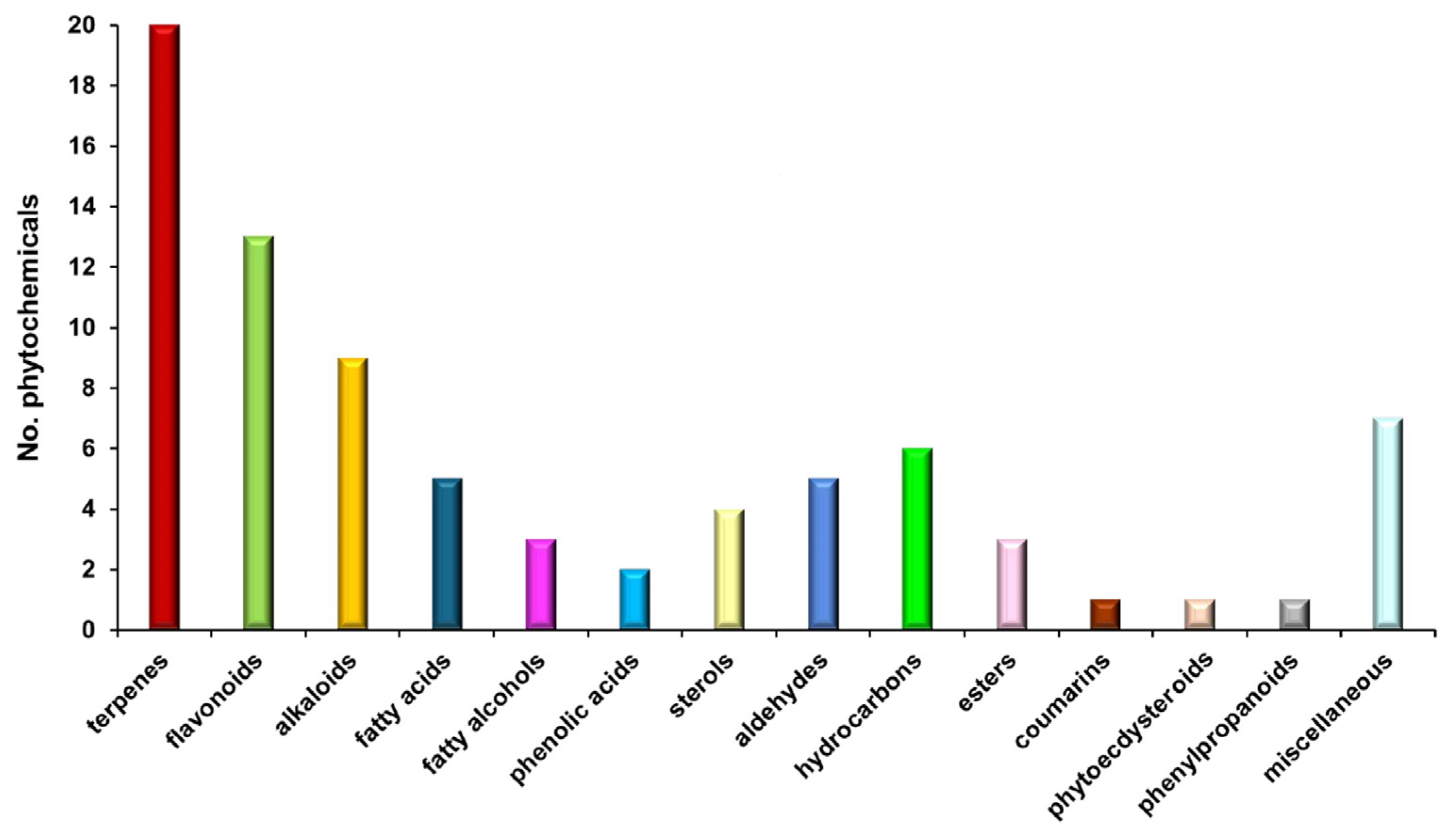
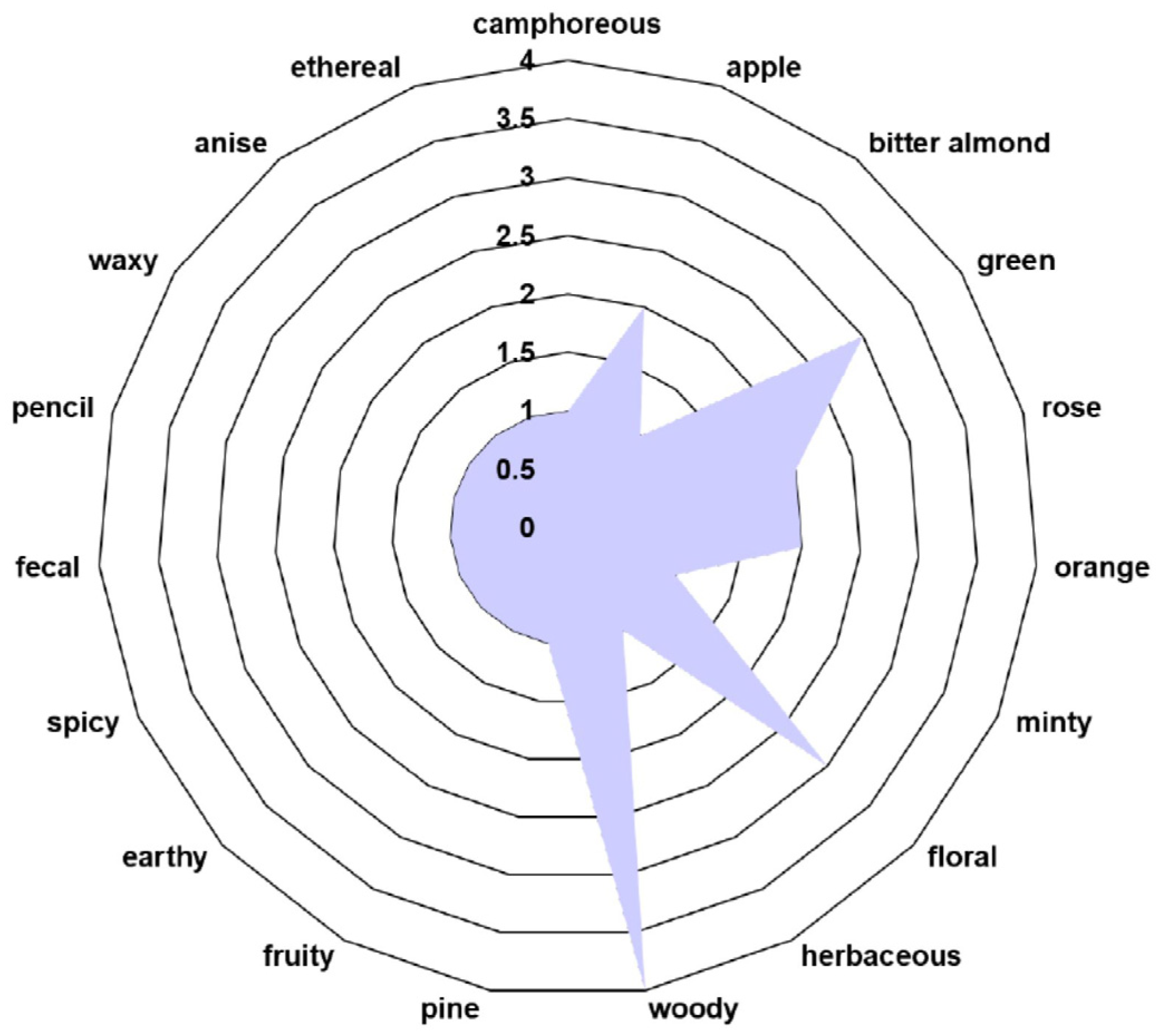
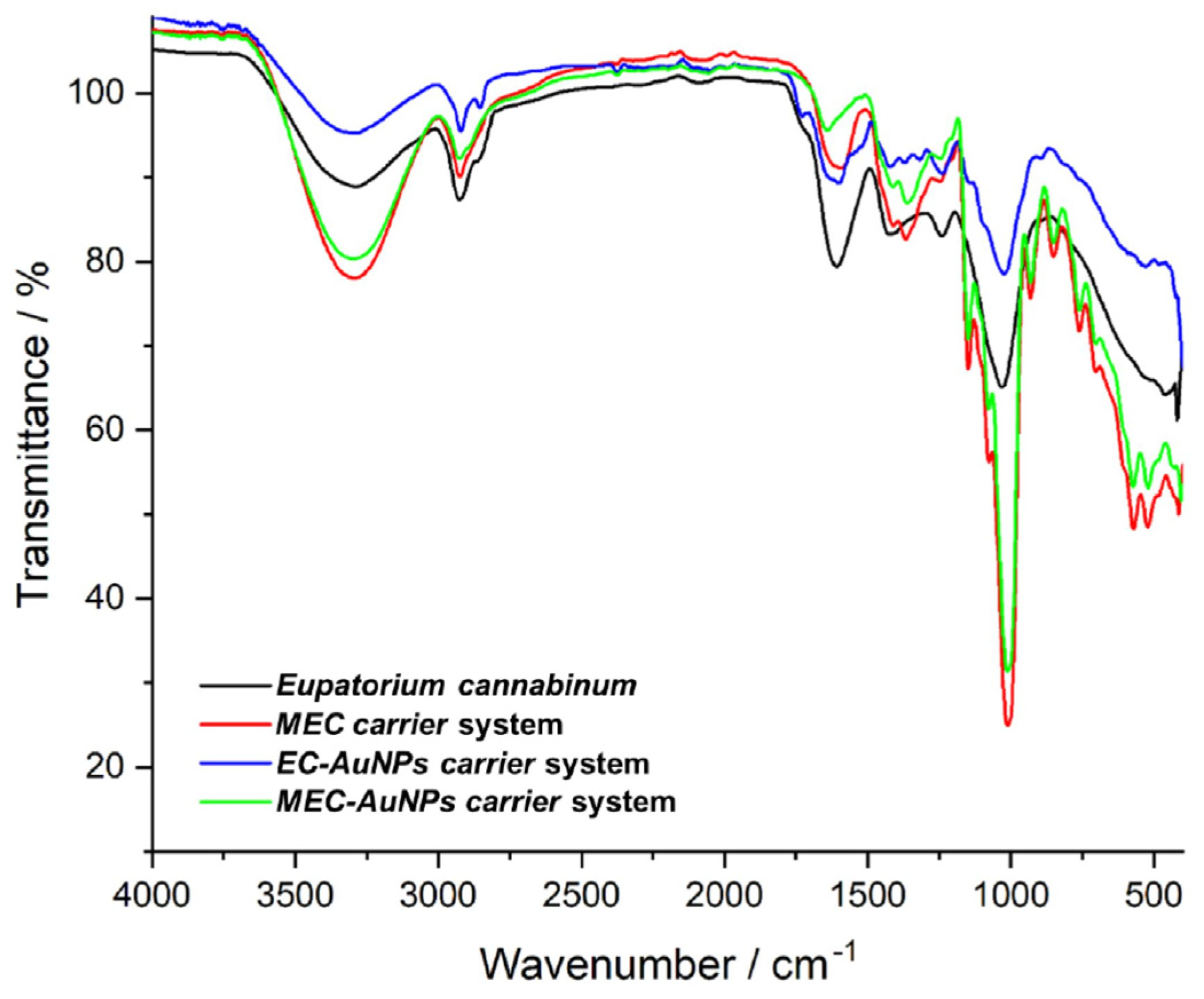

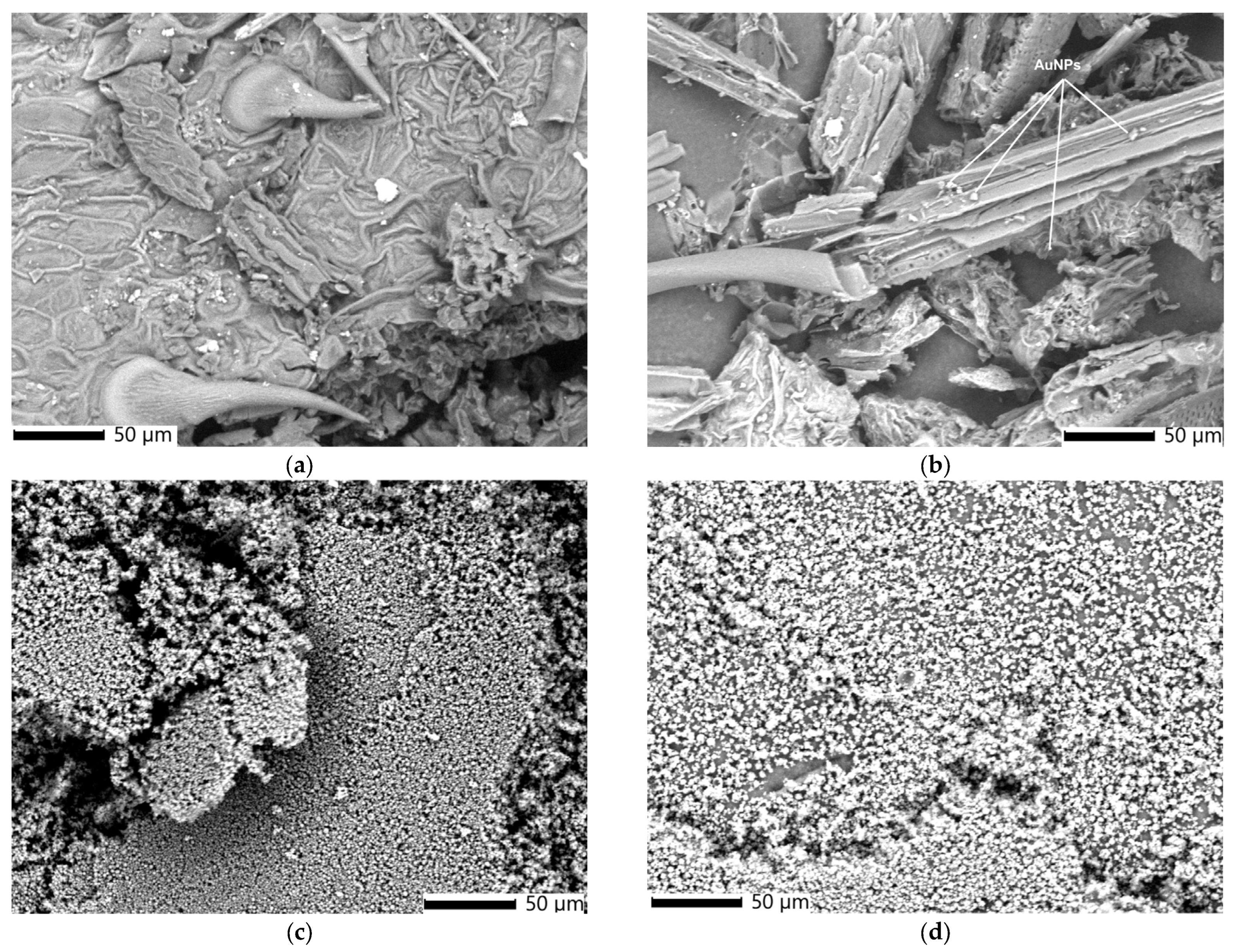
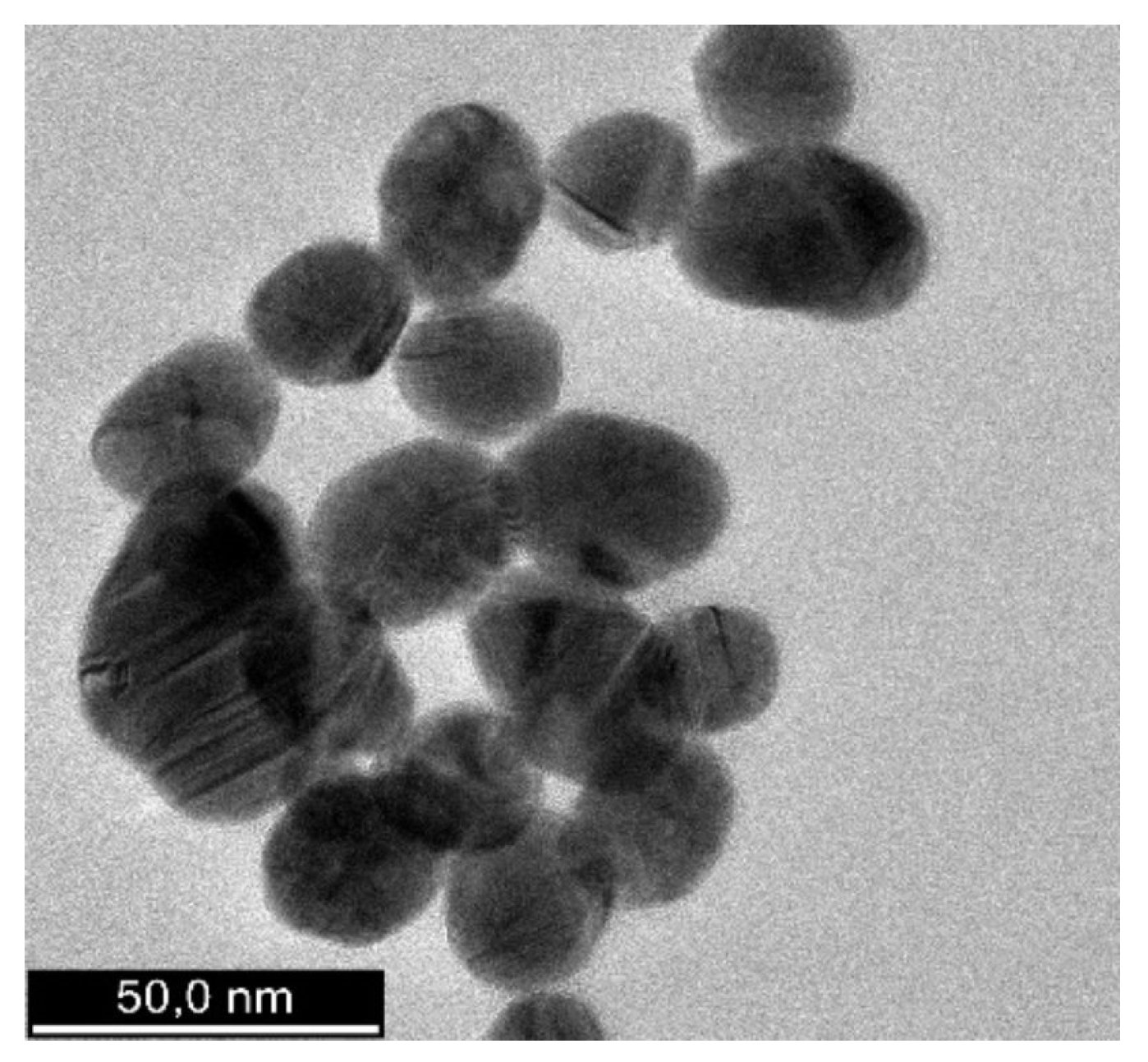


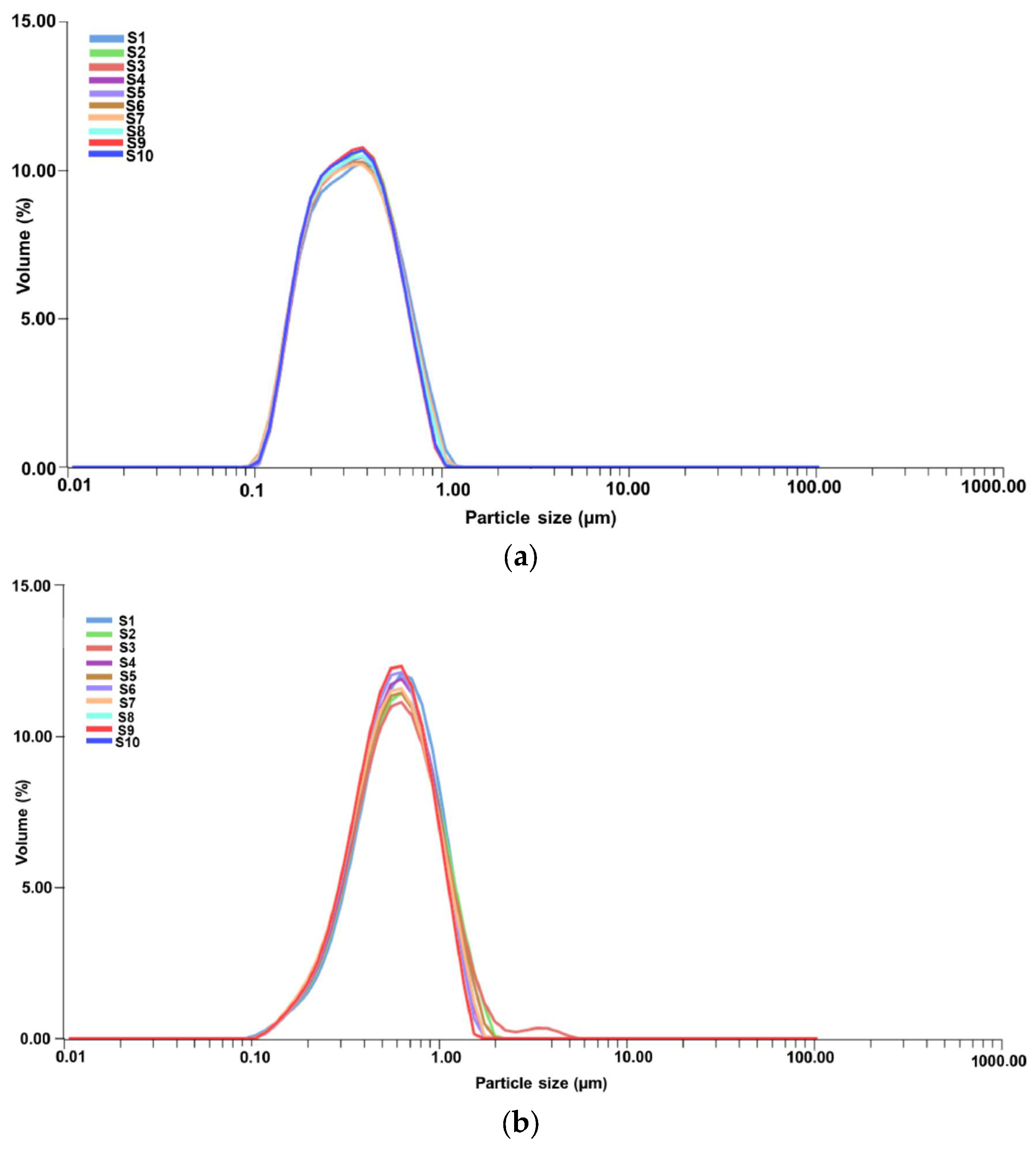
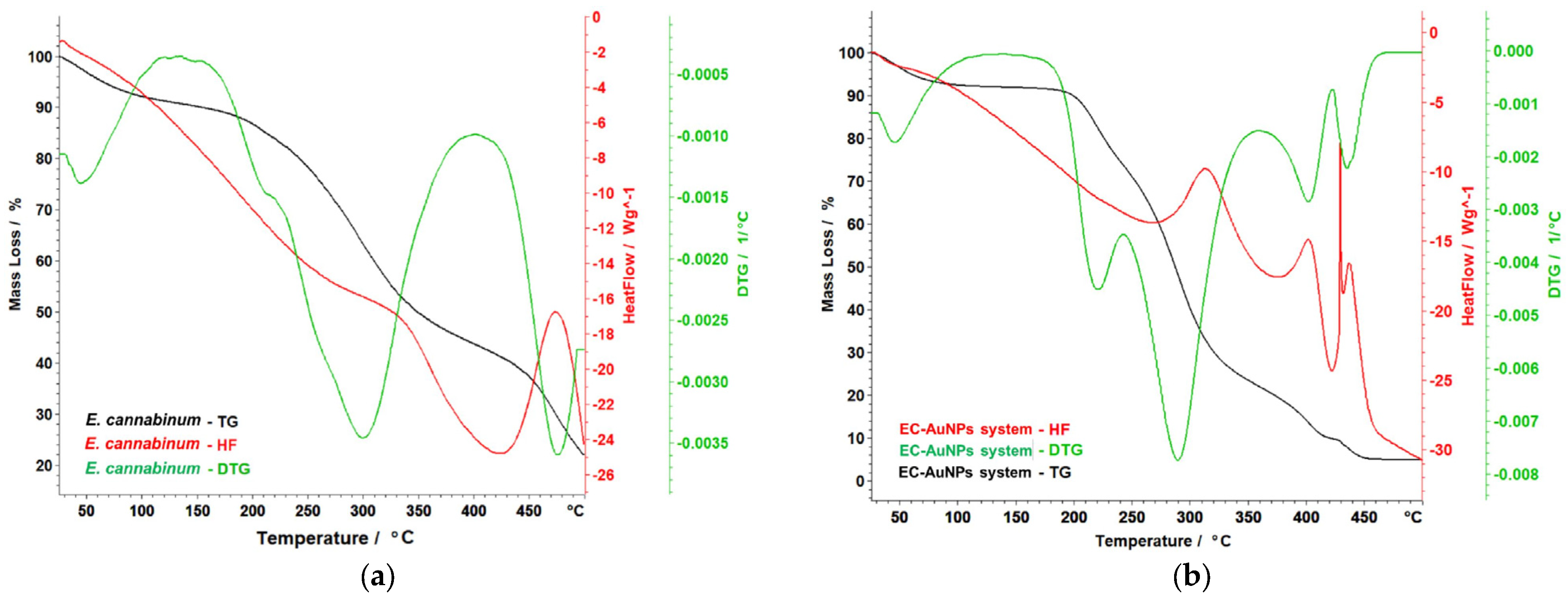
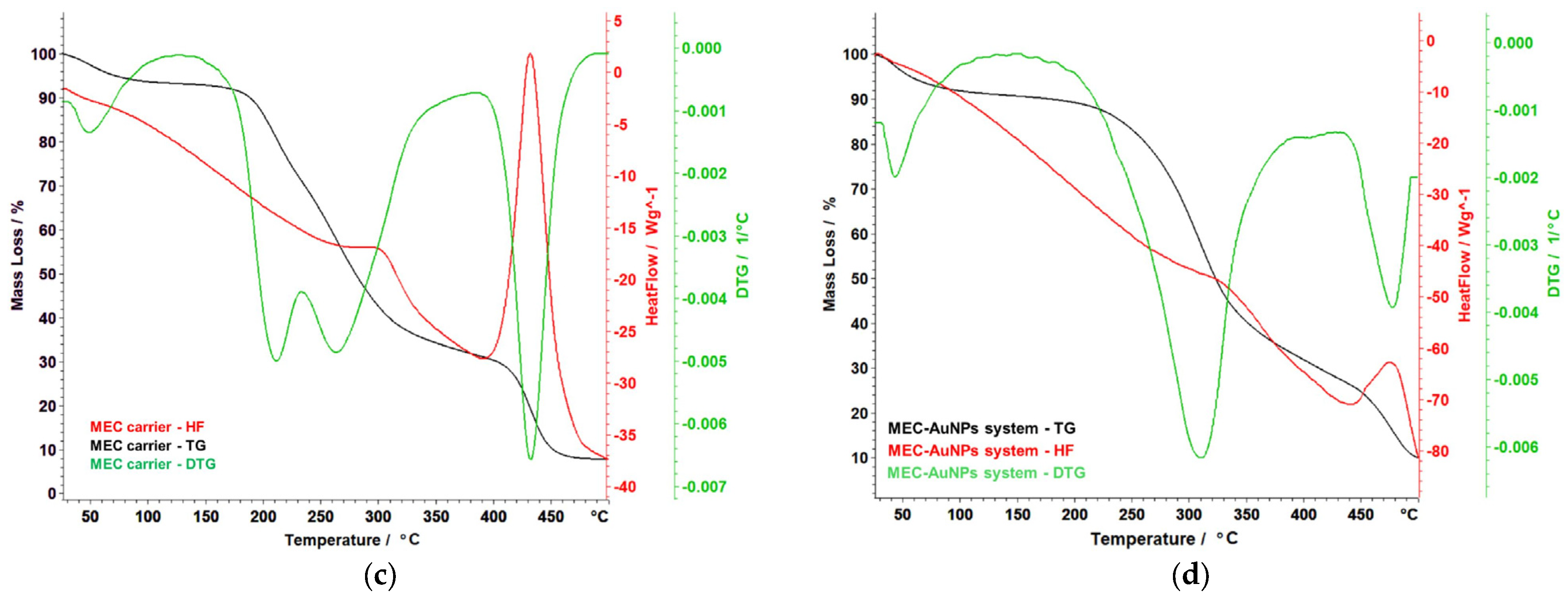
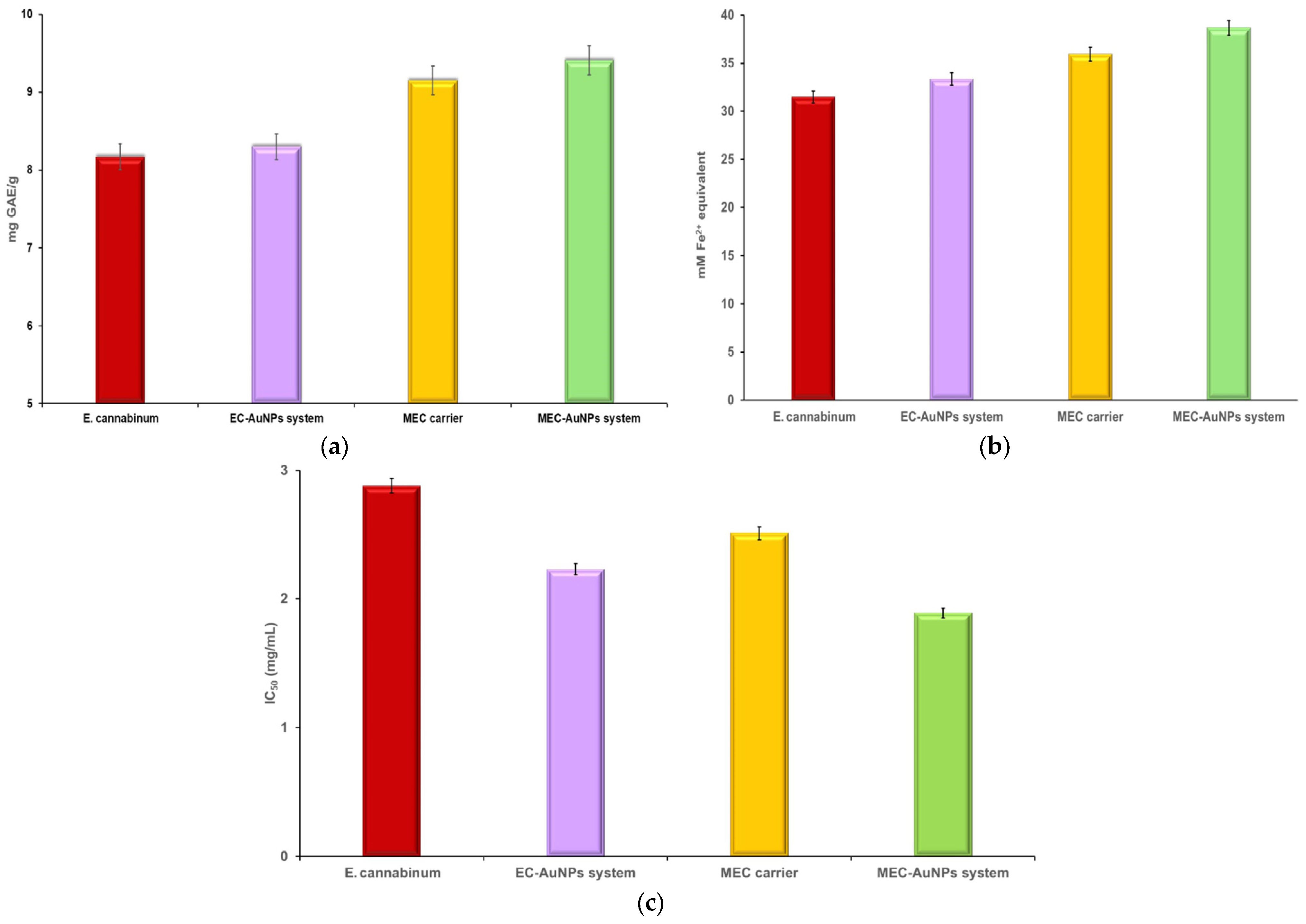
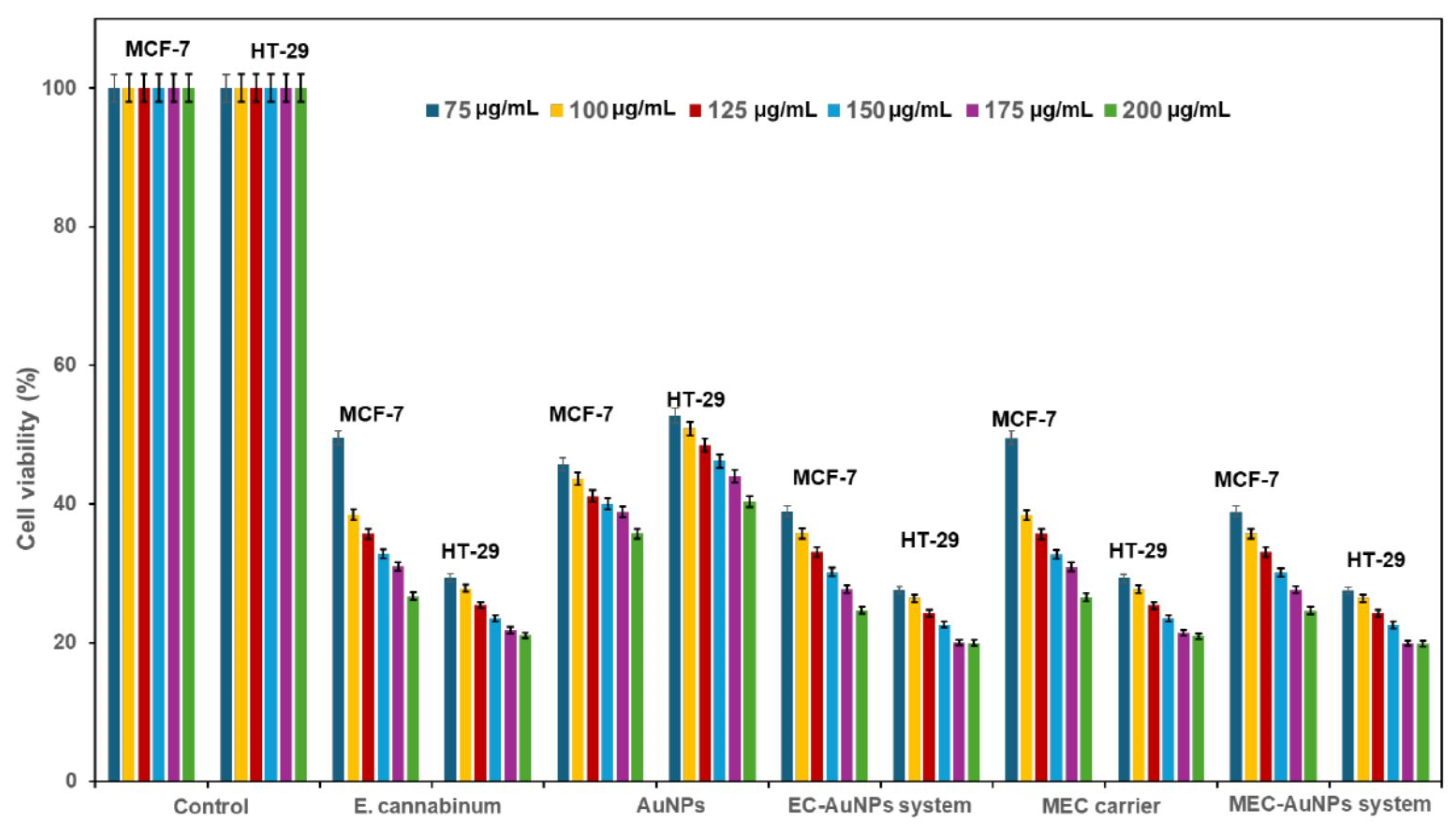

| No. | tR (min) | RI | Kováts RI | Compound | Formula | MW (g/mol) | Area (%) | Ref. |
|---|---|---|---|---|---|---|---|---|
| 1 | 3.76 | 822 | 829 | 2-hexenal | C6H10O | 98.14 | 1.24 | [55,61] |
| 2 | 5.78 | 928 | 901 | heptanal | C7H14O | 114.19 | 2.19 | [62] |
| 3 | 7.02 | 1022 | 1026 | p-cymene | C10H14 | 134.22 | 0.89 | [55,63] |
| 4 | 10.89 | 957 | 954 | benzaldehyde | C7H6O | 106.12 | 0.92 | [62] |
| 5 | 11.37 | 1979 | 1973 | palmitic acid | C16H32O2 | 256.42 | 1.89 | [54] |
| 6 | 12.76 | 1985 | 1089 | terpinolene | C10H16 | 136.23 | 0.91 | [64] |
| 7 | 14.92 | 1321 | 1113 | linalool | C10H18O | 154.25 | 2.18 | [65] |
| 8 | 16.53 | 1599 | 1601 | hexadecane | C16H34 | 226.44 | 1.22 | [54] |
| 9 | 17.66 | 1109 | 1095 | nonanal | C9H18O | 142.24 | 6.67 | [66] |
| 10 | 22.27 | 1795 | 1743 | chamazulene | C14H16 | 184.28 | 11.53 | [67] |
| 11 | 24.82 | 1197 | 1199 | decanal | C10H20O | 156.26 | 2.21 | [66] |
| 12 | 27.75 | 1921 | 1918 | thymol | C10H14O | 150.22 | 3.35 | [65] |
| 13 | 29.86 | 2077 | 2080 | phytol | C20H40O | 296.50 | 2.89 | [54] |
| 14 | 31.55 | 1551 | 1553 | 8,9-dehydrothymol | C10H12O | 148.20 | 2.67 | [68] |
| 15 | 32.74 | 1243 | 1245 | methyl thymol | C11H16O | 164.24 | 2.85 | [64] |
| 16 | 34.48 | 1579 | 1578 | spathulenol | C15H24O | 220.35 | 1.95 | [55,63] |
| 17 | 35.93 | 1803 | 1805 | octadecane | C18H38 | 254.50 | 6.58 | [62] |
| 18 | 37.69 | 1899 | 1901 | nonadecane | C19H40 | 268.50 | 19.72 | [62] |
| 19 | 39.57 | 3292 | 3294 | β-sitosterol | C29H50O | 414.70 | 0.97 | [54] |
| 20 | 41.27 | 1295 | 1497 | germacrene D | C15H24 | 204.35 | 1.96 | [55,63] |
| 21 | 43.17 | 2695 | 2999 | eicosane | C20H42 | 282.50 | 2.05 | [69] |
| 22 | 45.14 | 1363 | 1364 | neryl acetate | C12H20O2 | 196.29 | 1.53 | [70] |
| 23 | 47.84 | 1355 | 1531 | cadinene | C15H26 | 204.35 | 0.95 | [55] |
| 24 | 61.75 | 1625 | 1627 | eudesmol | C15H26O | 222.37 | 3.33 | [71] |
| No. | m/z Detected | Theoretic m/z | Formula | Tentative of Identification | Category | Ref. |
|---|---|---|---|---|---|---|
| 1 | 147.15 | 146.14 | C9H6O2 | coumarin | coumarins | [10] |
| 2 | 257.43 | 256.42 | C16H32O2 | palmitic acid | fatty acids | [5,76] |
| 3 | 279.39 | 278.40 | C18H30O2 | α-linolenic acid | fatty acids | [76] |
| 4 | 281.39 | 280.40 | C18H32O2 | linoleic acid | fatty acids | [76] |
| 5 | 283.51 | 282.50 | C18H34O2 | oleic acid | fatty acids | [76] |
| 6 | 287.23 | 286.24 | C15H10O6 | kaempferol | flavonoids | [5,17] |
| 7 | 303.24 | 302.23 | C15H10O7 | quercetin | flavonoids | [5,18] |
| 8 | 315.29 | 314.29 | C17H14O6 | pectolinaringenin | flavonoids | [17] |
| 9 | 331.28 | 330.29 | C17H14O7 | jaceosidin | flavonoids | [17] |
| 10 | 333.27 | 332.26 | C16H12O8 | patuletin | flavonoids | [76] |
| 11 | 345.29 | 344.30 | C18H16O7 | eupatilin | flavonoids | [10,17] |
| 12 | 361.29 | 360.30 | C18H16O8 | centaureidin | flavonoids | [17] |
| 13 | 345.29 | 344.30 | C18H16O7 | eupatorin | flavonoids | [5,10] |
| 14 | 301.27 | 300.26 | C16H12O6 | hyspidulin | flavonoids | [5,17] |
| 15 | 449.41 | 448.40 | C21H20O11 | astragalin | flavonoids | [5,17] |
| 16 | 465.39 | 464.40 | C21H20O12 | hyperoside | flavonoids | [5,17] |
| 17 | 595.51 | 594.50 | C27H30O15 | nicotiflorin | flavonoids | [76] |
| 18 | 611.49 | 610.50 | C27H30O16 | rutin | flavonoids | [17,18] |
| 19 | 181.17 | 180.16 | C9H8O4 | caffeic acid | phenolic acids | [18] |
| 20 | 355.31 | 354.31 | C16H18O9 | chlorogenic acid | phenolic acids | [17] |
| 21 | 101.13 | 100.12 | C5H8O2 | angelic acid | alkaloids | [72] |
| 22 | 142.22 | 141.21 | C8H15NO | trachelanthamidine | alkaloids | [72] |
| 23 | 156.20 | 155.19 | C8H13NO2 | trachelantic acid | alkaloids | [72] |
| 24 | 157.21 | 157.21 | C8H15NO2 | turneforcidine | alkaloids | [73] |
| 25 | 163.19 | 162.18 | C7H14O4 | viridifloric acid | alkaloids | [72] |
| 26 | 283.37 | 283.36 | C15H25NO4 | supinine | alkaloids | [72] |
| 27 | 286.37 | 285.38 | C15H27NO4 | lindefoline | alkaloids | [72] |
| 28 | 289.33 | 288.34 | C17H20O4 | 9-acetoxy-8,10-epoxythymol 3-O-tiglate | alkaloids | [10] |
| 29 | 300.37 | 299.36 | C15H25NO5 | rinderine | alkaloids | [72] |
| 30 | 401.71 | 400.70 | C28H48O | campesterol | sterols | [76] |
| 31 | 413.69 | 412.70 | C29H48O | stigmasterol | sterols | [10] |
| 32 | 427.69 | 426.70 | C30H50O | taraxasterol | sterols | [10] |
| 33 | 415.71 | 414.70 | C29H50O | β-sitosterol | sterols | [10] |
| 34 | 135.23 | 134.22 | C10H14 | p-cymene | terpenes | [10,73] |
| 35 | 137.24 | 136.23 | C10H16 | terpinolene | terpenes | [5,73,74] |
| 36 | 149.21 | 148.20 | C10H12O | 8,9-dehydrothymol | terpenes | [10] |
| 37 | 151.23 | 150.22 | C10H14O | thymol | terpenes | [5,10,73] |
| 38 | 155.25 | 154.25 | C10H18O | linalool | terpenes | [5,73] |
| 39 | 165.23 | 164.24 | C11H16O | methyl thymol | terpenes | [10,16,73] |
| 40 | 185.27 | 184.27 | C11H20O2 | hexyl tiglate | terpenes | [73] |
| 41 | 185.29 | 184.28 | C14H16 | chamazulene | terpenes | [5,74] |
| 42 | 193.31 | 192.30 | C13H20O | beta-ionone | terpenes | [10] |
| 43 | 197.28 | 196.29 | C12H20O2 | neryl acetate | terpenes | [16,73] |
| 44 | 201.22 | 200.23 | C13H12O2 | dehydrotremetone | terpenes | [72] |
| 45 | 203.24 | 202.25 | C13H14O2 | tremetone | terpenes | [72] |
| 46 | 205.36 | 204.35 | C15H24 | germacrene D | terpenes | [10,16,73,74] |
| 47 | 207.36 | 206.37 | C15H26 | cadinene | terpenes | [5] |
| 48 | 221.34 | 220.35 | C15H24O | spathulenol | terpenes | [16,74] |
| 49 | 223.26 | 222.37 | C15H26O | eudesmol | terpenes | [5,10] |
| 50 | 249.33 | 248.32 | C15H20O3 | eupatolide | terpenes | [77] |
| 51 | 297.51 | 296.50 | C20H40O | phytol | terpenes | [5,74] |
| 52 | 363.39 | 362.40 | C20H26O6 | eupatoriopicrin | terpenes | [77] |
| 53 | 427.71 | 426.70 | C30H50O | α-amyrin | terpenes | [76] |
| 54 | 465.59 | 464.60 | C27H44O6 | β-ecdysone | phytoecdysteroids | [10] |
| 55 | 149.19 | 148.20 | C10H12O | estragole | phenylpropanoids | [72] |
| 56 | 243.43 | 242.44 | C16H34O | cetyl alcohol | fatty alcohols | [10] |
| 57 | 271.51 | 270.50 | C18H38O | stearyl alcohol | fatty alcohols | [74,76] |
| 58 | 327.59 | 326.60 | C22H46O | n-docosanol | fatty alcohols | [76] |
| 59 | 299.49 | 298.50 | C20H42O | arachidyl alcohol | fatty alcohols | [76] |
| 60 | 227.43 | 226.44 | C16H34 | hexadecane | hydrocarbons | [5,73] |
| 61 | 255.51 | 254.50 | C18H38 | octadecane | hydrocarbons | [73] |
| 62 | 269.49 | 268.50 | C19H40 | n-nonadecane | hydrocarbons | [74] |
| 63 | 283.51 | 282.50 | C20H42 | n-eicosane | hydrocarbons | [10] |
| 64 | 297.61 | 296.60 | C21H44 | n-heneicosane | hydrocarbons | [10] |
| 65 | 311.59 | 310.60 | C22H46 | n-docosane | hydrocarbons | [10] |
| 66 | 49.08 | 46.07 | C2H6O | dimethyl ether | miscellaneous | [76] |
| 67 | 118.14 | 117.15 | C8H7N | indole | miscellaneous | [73] |
| 68 | 123.15 | 122.16 | C8H10O | 2-phenylethanol | miscellaneous | [5,73] |
| 69 | 139.22 | 138.21 | C9H14O | 2-pentylfuran | miscellaneous | [73] |
| 70 | 153.24 | 152.23 | C10H16O | 2-hexylfuran | miscellaneous | [5] |
| 71 | 165.21 | 164.20 | C10H12O2 | thymoquinone | miscellaneous | [10] |
| 72 | 218.26 | 218.25 | C13H14O3 | hydroxytremetone | miscellaneous | [76] |
| 73 | 225.33 | 224.34 | C14H24O2 | bornyl isobutanoate | esters | [10] |
| 74 | 239.38 | 238.37 | C15H26O2 | neryl isovalerate | esters | [10] |
| 75 | 284.37 | 283.36 | C15H25NO4 | amabiline | esters | [75] |
| 76 | 99.15 | 98.14 | C6H10O | 2-hexanal | aldehydes | [73] |
| 77 | 107.13 | 106.12 | C7H6O | benzaldehyde | aldehydes | [5,10,73] |
| 78 | 121.14 | 120.15 | C8H8O | phenylacetaldehyde | aldehydes | [73] |
| 79 | 143.25 | 142.24 | C9H18O | nonanal | aldehydes | [10] |
| 80 | 157.25 | 156.26 | C10H20O | decanal | aldehydes | [10] |
| VOC Name | Odor |
|---|---|
| bornyl isobutanoate | camphoraceous |
| neryl isovalerate | apple |
| benzaldehyde | bitter almond |
| 2-hexenal | green |
| phenylacetaldehyde | green |
| nonanal | rose |
| decanal | orange |
| carvone | minty |
| limonene | citric |
| phytol | floral |
| thymol | herbaceous |
| chamazulene | apples |
| β-ionone | floral |
| linalool | floral |
| β-caryophyllene | woody |
| p-cymene | woody |
| terpinolene | pine |
| neryl acetate | fruity |
| germacrene D | woody |
| cadinene | woody |
| spathulenol | earthy |
| eudesmol | spicy |
| 2-phenylethanol | rose |
| indole | fecal |
| thymoquinone | pencil |
| cetyl alcohol | waxy |
| hexyl tiglate | green |
| methyl thymol | woody |
| Phytochemicals Category | Wavenumber (cm−1) | Ref. |
|---|---|---|
| terpenoids | 2348, 1738, 1088, 812 | [78] |
| alkaloids | 1637, 1600, 1404, 740, 665 | [78] |
| coumarins | 3429, 1728, 1609, 1267, 1135, 1255, 902–601 | [79] |
| flavonoids | 3402–3102, 1524, 1462, 1436, 1366, 1272 | [55,80] |
| phenolic acids | 1366, 1253, 1242, 1169–1102, 1032 | [78,80] |
| fatty acids | 2922, 1349, 1249, 1091, 745, 722 | [47] |
| phytosterols | 1463, 1380, 1060, 740 | [81] |
| phenylpropanoids | 3188, 3002, 1636, 1504, 1449, 1248 | [82] |
| phytoecdysteroids | 3305, 1655 | [83,84] |
| Sample | Particle Size Diameter (μm) | Volume Diameter (μm) | |||
|---|---|---|---|---|---|
| D[3,2] | D[4,3] | d10 | d50 | d90 | |
| MEC carrier | 0.298 ± 0.002 | 0.380 ± 0.003 | 0.121 ± 0.001 | 0.312 ± 0.002 | 0.714 ± 0.006 |
| MEC-AuNPs system | 0.521 ± 0.004 | 0.649 ± 0.006 | 0.186 ± 0.001 | 0.689 ± 0.005 | 1.123 ± 0.013 |
| Sample Name | EE% | EC% | EY% |
|---|---|---|---|
| MEC carrier | 61.12 ± 0.11 | 59.39 ± 0.26 | 60.55 ± 0.41 |
| MEC-AuNPs system | 61.85 ± 0.12 | 61.11 ± 0.36 | 61.27 ± 0.48 |
| Pathogenic Microorganism | Sample | Inhibition Zone Diameter (mm) | ||||||
|---|---|---|---|---|---|---|---|---|
| Sample Concentration (μg/mL) | Positive Control (Gentamicin 100 μg/mL) | Negative Control (DMSO) | ||||||
| 100 | 125 | 150 | 175 | 200 | ||||
| Staphylococcus aureus | E. cannabinum | 37.13 ± 0.54 | 45.12 ± 0.87 | 56.33 ± 0.72 | 61.27 ± 0.41 | 67.16 ± 0.52 | 9.58 ± 0.51 | 0 |
| EC-AuNPs system | 45.38 ± 0.25 | 51.06 ± 0.38 | 60.24 ± 0.29 | 69.73 ± 0.41 | 71.04 ± 0.38 | |||
| citrate-coated AuNPs | 3.05 ± 0.21 | 4.82 ± 0.32 | 6.33 ± 0.18 | 7.24 ± 0.62 | 8.05 ± 0.62 | |||
| MEC carrier | 39.49 ± 0.27 | 47.32 ± 0.45 | 59.46 ± 0.34 | 65.22 ± 0.11 | 70.33 ± 0.41 | |||
| MEC-AuNPs system | 48.62 ± 0.62 | 57.19 ± 0.36 | 62.53 ± 0.25 | 71.15 ± 0.42 | 74.07 ± 0.16 | |||
| Bacillus subtilis | E. cannabinum | 35.03 ± 0.13 | 46.25 ± 0.33 | 57.81 ± 0.44 | 63.26 ± 0.16 | 68.14 ± 0.22 | 17.91 ± 0.17 | 0 |
| EC-AuNPs system | 46.78 ± 0.32 | 53.02 ± 0.41 | 61.56 ± 0.35 | 70.68 ± 0.52 | 72.57 ± 0.27 | |||
| citrate-coated AuNPs | 3.13 ± 0.33 | 4.98 ± 0.45 | 6.78 ± 0.42 | 7.47 ± 0.22 | 8.85 ± 0.37 | |||
| MEC carrier | 36.11 ± 0.23 | 46.25 ± 0.33 | 57.81 ± 0.44 | 63.26 ± 0.16 | 68.14 ± 0.22 | |||
| MEC-AuNPs system | 48.17 ± 0.34 | 54.87 ± 0.41 | 62.08 ± 0.23 | 72.32 ± 0.51 | 74.79 ± 0.33 | |||
| Bacillus cereus | E. cannabinum | 36.17 ± 0.44 | 47.81 ± 0.19 | 57.83 ± 0.32 | 64.06 ± 0.23 | 69.76 ± 0.63 | 28.64 ± 09 | 0 |
| EC-AuNPs system | 48.03 ± 0.27 | 55.31 ± 0.15 | 63.41 ± 0.43 | 73.02 ± 0.33 | 74.14 ± 0.33 | |||
| citrate-coated AuNPs | 3.49 ± 0.81 | 4.83 ± 0.26 | 6.75 ± 0.17 | 7.49 ± 0.31 | 8.94 ± 0.14 | |||
| MEC carrier | 38.03 ± 0.26 | 48.42 ± 0.18 | 59.34 ± 0.47 | 66.65 ± 0.62 | 72.03 ± 0.38 | |||
| MEC-AuNPs system | 50.01 ± 0.71 | 57.14 ± 0.36 | 65.22 ± 0.47 | 74.92 ± 0.19 | 76.26 ± 0.51 | |||
| Pseudomonas aeruginosa | E. cannabinum | 33.42 ± 0.37 | 41.21 ± 0.52 | 50.84 ± 0.35 | 61.36 ± 0.27 | 66.94 ± 0.45 | 18.64 ± 0.13 | 0 |
| EC-AuNPs system | 39.92 ± 0.43 | 45.81 ± 0.21 | 54.16 ± 0.46 | 65.74 ± 0.16 | 69.27 ± 0.53 | |||
| citrate-coated AuNPs | 3.51 ± 0.11 | 4.86 ± 0.32 | 6.71 ± 0.27 | 7.51 ± 0.43 | 8.91 ± 0.58 | |||
| MEC carrier | 36.55 ± 0.25 | 44.74 ± 0.19 | 53.75 ± 0.41 | 64.86 ± 0.17 | 69.87 ± 0.53 | |||
| MEC-AuNPs system | 41.33 ± 0.63 | 47.46 ± 0.33 | 55.48 ± 0.21 | 67.33 ± 0.42 | 71.49 ± 0.17 | |||
| Escherichia coli | E. cannabinum | 35.49 ± 0.72 | 46.65 ± 0.63 | 56.48 ± 0.27 | 63.82 ± 0.36 | 69.12 ± 0.51 | 20.71 ± 0.28 | 0 |
| EC-AuNPs system | 47.21 ± 0.15 | 54.72 ± 0.46 | 62.58 ± 0.32 | 72.74 ± 0.29 | 73.63 ± 0.31 | |||
| citrate-coated AuNPs | 12.41 ± 0.22 | 15.15 ± 0.41 | 17.84 ± 0.53 | 19.94 ± 0.37 | 22.08 ± 0.25 | |||
| MEC carrier | 37.21 ± 0.53 | 48.52 ± 0.34 | 58.17 ± 0.41 | 65.35 ± 0.62 | 70.94 ± 0.19 | |||
| MEC-AuNPs system | 48.98 ± 0.34 | 56.07 ± 0.21 | 63.75 ± 0.18 | 74.09 ± 0.11 | 75.18 ± 0.45 | |||
| Salmonella typhi | E. cannabinum | 34.22 ± 0.31 | 45.78 ± 0.15 | 55.32 ± 0.23 | 62.44 ± 0.42 | 68.54 ± 0.47 | 12.09 ± 38 | 0 |
| EC-AuNPs system | 59.93 ± 0.22 | 66.48 ± 0.17 | 80.25 ± 0.34 | 89.88 ± 0.56 | 94.06 ± 0.17 | |||
| citrate-coated AuNPs | 23.88 ± 0.22 | 39.03 ± 0.16 | 46.27 ± 0.35 | 52.18 ± 0.42 | 59.66 ± 0.17 | |||
| MEC carrier | 38.07 ± 0.35 | 47.11 ± 0.22 | 56.78 ± 0.44 | 64.11 ± 0.18 | 69.87 ± 0.53 | |||
| MEC-AuNPs system | 62.53 ± 0.41 | 68.22 ± 0.34 | 82.07 ± 0.15 | 91.77 ± 0.41 | 96.24 ± 0.62 | |||
| Pathogenic Microorganism | Sample | MIC (μg/mL) | MBC (μg/mL) | Gentamicin | |
|---|---|---|---|---|---|
| MIC (μg/mL) | MBC (μg/mL) | ||||
| Staphylococcus aureus | E. cannabinum | 0.29 ± 0.12 | 0.30 ± 0.23 | 0.61 ± 0.56 | 0.61 ± 0.56 |
| citrate-coated AuNPs | 0.42 ± 0.17 | 0.41 ± 0.09 | |||
| EC-AuNPs system | 0.21 ± 0.03 | 0.20 ± 0.16 | |||
| MEC carrier | 0.23 ± 0.22 | 0.22 ± 0.18 | |||
| MEC-AuNPs system | 0.19 ± 0.22 | 0.18 ± 0.18 | |||
| Bacillus subtilis | E. cannabinum | 0.33 ± 0.16 | 0.32 ± 0.14 | 0.48 ± 0.21 | 0.44 ± 0.17 |
| citrate-coated AuNPs | 0.43 ± 0.04 | 0.42 ± 0.08 | |||
| EC-AuNPs system | 0.26 ± 0.13 | 0.24 ± 0.09 | |||
| MEC carrier | 0.31 ± 0.18 | 0.30 ± 0.23 | |||
| MEC-AuNPs system | 0.28 ± 0.11 | 0.27 ± 0.15 | |||
| Pseudomonas aeruginosa | E. cannabinum | 0.83 ± 0.17 | 0.81 ± 0.11 | 1.28 ± 0.02 | 1.27 ± 0.06 |
| citrate-coated AuNPs | 0.74 ± 0.31 | 0.73 ± 0.29 | |||
| EC-AuNPs system | 0.64 ± 0.22 | 0.62 ± 0.17 | |||
| MEC carrier | 0.79 ± 0.13 | 0.78 ± 0.07 | |||
| MEC-AuNPs system | 0.61 ± 0.17 | 0.60 ± 0.09 | |||
| Bacillus cereus | E. cannabinum | 0.98 ± 0.11 | 0.99 ± 0.14 | 1.98 ± 0.34 | 1.97 ± 0.27 |
| citrate-coated AuNPs | 0.73 ± 0.23 | 0.72 ± 0.21 | |||
| EC-AuNPs system | 0.52 ± 0.07 | 0.59 ± 0.37 | |||
| MEC carrier | 0.87 ± 0.04 | 0.86 ± 0.07 | |||
| MEC-AuNPs system | 0.48 ± 0.14 | 0.47 ± 0.21 | |||
| Escherichia coli | E. cannabinum | 0.68 ± 0.05 | 0.65 ± 0.18 | 0.82 ± 0.19 | 0.82 ± 0.17 |
| citrate-coated AuNPs | 0.42 ± 0.14 | 0.41 ± 0.11 | |||
| EC-AuNPs system | 0.38 ± 0.09 | 0.37 ± 0.16 | |||
| MEC carrier | 0.64 ± 0.22 | 0.62 ± 0.27 | |||
| MEC-AuNPs system | 0.28 ± 0.05 | 0.28 ± 0.07 | |||
| Salmonella typhi | E. cannabinum | 0.62 ± 0.14 | 0.62 ± 0.12 | 1.12 ± 0.26 | 1.11 ± 0.31 |
| citrate-coated AuNPs | 0.38 ± 0.21 | 0.37 ± 0.17 | |||
| EC-AuNPs system | 0.33 ± 0.23 | 0.32 ± 0.19 | |||
| MEC carrier | 0.58 ± 0.11 | 0.57 ± 0.08 | |||
| MEC-AuNPs system | 0.24 ± 0.09 | 0.23 ± 0.04 | |||
Disclaimer/Publisher’s Note: The statements, opinions and data contained in all publications are solely those of the individual author(s) and contributor(s) and not of MDPI and/or the editor(s). MDPI and/or the editor(s) disclaim responsibility for any injury to people or property resulting from any ideas, methods, instructions or products referred to in the content. |
© 2025 by the authors. Licensee MDPI, Basel, Switzerland. This article is an open access article distributed under the terms and conditions of the Creative Commons Attribution (CC BY) license (https://creativecommons.org/licenses/by/4.0/).
Share and Cite
Vlase, G.; Segneanu, A.-E.; Bejenaru, L.E.; Bradu, I.A.; Sicoe, C.; Vlase, T.; Mogoşanu, G.D.; Buema, G.; Herea, D.-D.; Ciocîlteu, M.V.; et al. Wild-Grown Romanian Eupatorium cannabinum: Advancing Phyto-Nanocarriers via Maltodextrin Micro-Spray Encapsulation—Metabolite Profiling, Antioxidant, Antimicrobial, and Cytotoxicity Insights. Polymers 2025, 17, 482. https://doi.org/10.3390/polym17040482
Vlase G, Segneanu A-E, Bejenaru LE, Bradu IA, Sicoe C, Vlase T, Mogoşanu GD, Buema G, Herea D-D, Ciocîlteu MV, et al. Wild-Grown Romanian Eupatorium cannabinum: Advancing Phyto-Nanocarriers via Maltodextrin Micro-Spray Encapsulation—Metabolite Profiling, Antioxidant, Antimicrobial, and Cytotoxicity Insights. Polymers. 2025; 17(4):482. https://doi.org/10.3390/polym17040482
Chicago/Turabian StyleVlase, Gabriela, Adina-Elena Segneanu, Ludovic Everard Bejenaru, Ionela Amalia Bradu, Crina Sicoe, Titus Vlase, George Dan Mogoşanu, Gabriela Buema, Dumitru-Daniel Herea, Maria Viorica Ciocîlteu, and et al. 2025. "Wild-Grown Romanian Eupatorium cannabinum: Advancing Phyto-Nanocarriers via Maltodextrin Micro-Spray Encapsulation—Metabolite Profiling, Antioxidant, Antimicrobial, and Cytotoxicity Insights" Polymers 17, no. 4: 482. https://doi.org/10.3390/polym17040482
APA StyleVlase, G., Segneanu, A.-E., Bejenaru, L. E., Bradu, I. A., Sicoe, C., Vlase, T., Mogoşanu, G. D., Buema, G., Herea, D.-D., Ciocîlteu, M. V., & Bejenaru, C. (2025). Wild-Grown Romanian Eupatorium cannabinum: Advancing Phyto-Nanocarriers via Maltodextrin Micro-Spray Encapsulation—Metabolite Profiling, Antioxidant, Antimicrobial, and Cytotoxicity Insights. Polymers, 17(4), 482. https://doi.org/10.3390/polym17040482









